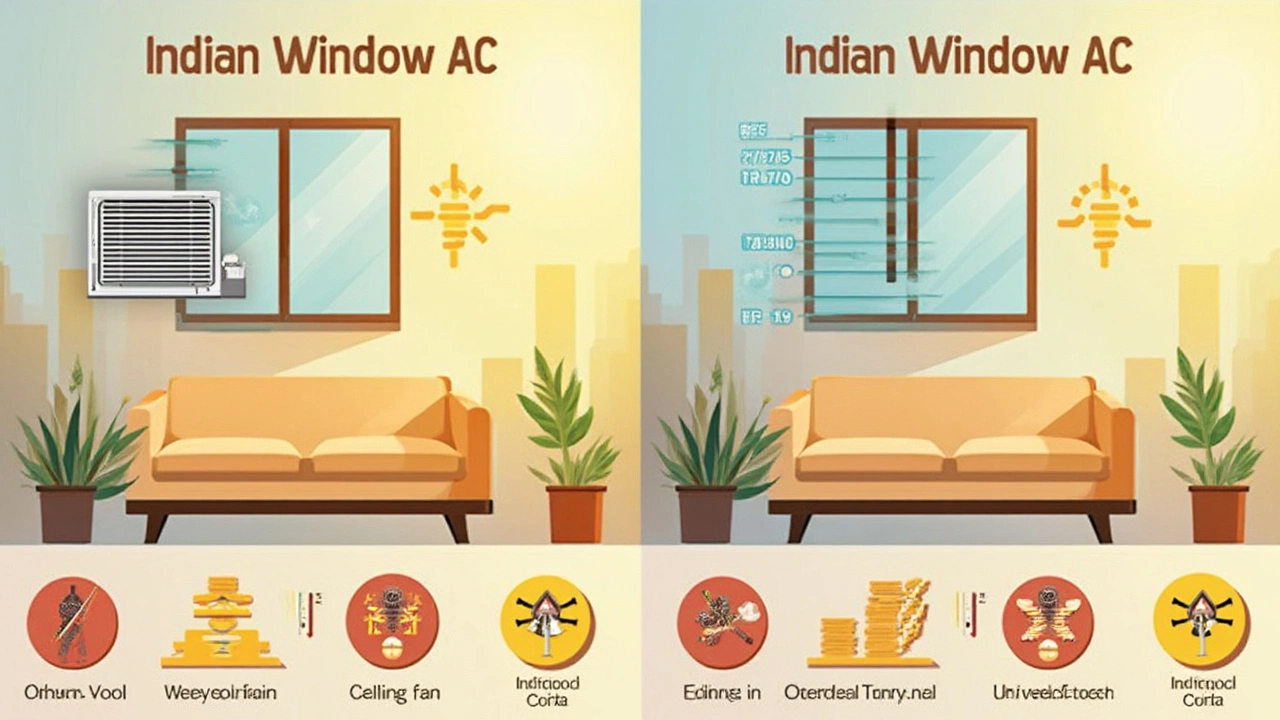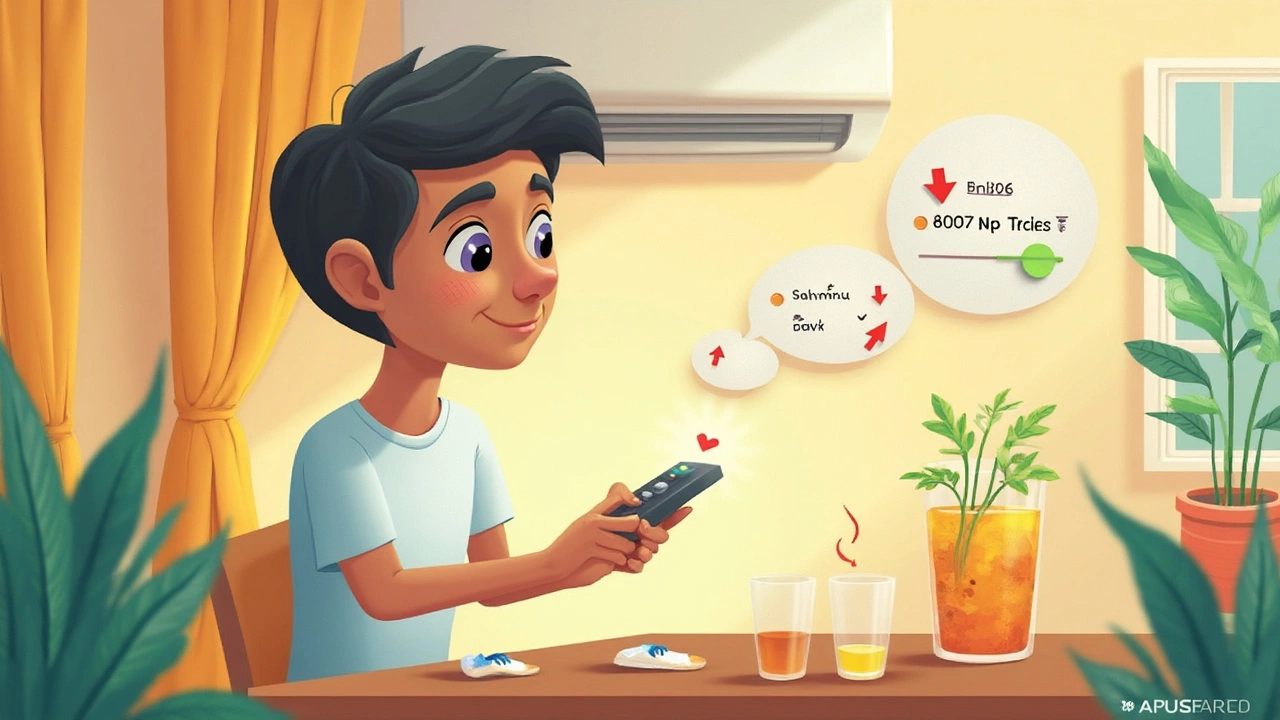
Got a window AC and worried about your next power bill? You're not alone. People often wonder if these compact coolers are quietly guzzling electricity when the heat cranks up. The short answer: they do use a noticeable amount of power, but not all units or homes are the same. Let’s get into the real numbers: a typical window AC unit runs anywhere from 500 to 1500 watts per hour. So, blasting a midsized window AC for 8 hours a day in July could add anywhere from $30 to $70 to your monthly bill, depending on your local electric rate.
This might sound steep at first, but it’s actually reasonable when you compare it to running your central AC just to cool one room. Window ACs target exactly where you need the cold, making them a money-saver in the right situation. Still, there are ways to keep those numbers even lower without sweating through the night—it's all about smart choices and knowing what really cranks up the usage.
- How Much Electricity Does a Window AC Use?
- Portable AC vs. Window AC: Which Is Cheaper to Run?
- Factors That Affect Energy Consumption
- Tips to Cut Down on AC Power Use
- How to Read Your AC's Energy Label
How Much Electricity Does a Window AC Use?
If you’ve ever glanced at your power bill after a hot month, you know running that window AC isn’t exactly free. But how much power is it really chewing through? Most window air conditioners pull between 500 and 1,500 watts per hour, depending on the size and how cold you set it. Here’s a quick way to look at real-life numbers:
| AC Size (BTUs) | Typical Wattage | Est. Cost per 8 hrs (at $0.15/kWh) |
|---|---|---|
| 5,000 | 500W | $0.60 |
| 10,000 | 900W | $1.08 |
| 15,000 | 1,500W | $1.80 |
That means if you’re running a medium-sized 10,000 BTU window AC for 8 hours, you’ll spend just over a buck a day. Do that every day for a month, and you’re looking at about $30–$35 extra on your electric bill.
Not all units are created equal. Older models often use more juice, while newer ENERGY STAR ones can drop usage by up to 15%. If you use the "Eco mode" or set the temp a notch higher, your power use shrinks, too.
- Check your AC’s wattage on its label—it’s usually right on the side or near the plug.
- Wattage = How much electricity is pulled when it runs.
- Multiply wattage by hours used to get your daily or monthly use. Throw your local cost-per-kWh into the mix, and you get your real spend.
This straight-up math shows a window AC can be cost-effective if you only need to cool one room. Compare that to firing up whole-house central air, and you’re already winning.
Portable AC vs. Window AC: Which Is Cheaper to Run?
The showdown between window AC units and portable air conditioners always comes down to the same thing: cash out of your pocket. If you’re picking based on electricity use, that window AC almost always wins. Here’s why.
Window ACs tend to use less electricity. They’re designed to sit right in your window, which means most of the hot air they pull out of your room goes straight outside. That’s way more efficient than a portable AC, which usually sends hot air out a plastic hose. What the box doesn’t always say is that portable units often suck air from inside the room, creating a little vacuum that pulls hot air right back in through any crack or gap. That means your portable AC has to work harder and use more power to keep things cool.
Want numbers? A typical window AC rated for a single room (let’s say about 8,000 BTUs) might use 700–900 watts per hour. A portable AC with the same cooling power is closer to 1,000–1,400 watts. Over a week of summer use, that gap adds up fast.
| Unit Type | Average Wattage | Estimated Monthly Cost* (8 hours/day) |
|---|---|---|
| Window AC (8,000 BTU) | 700–900W | $20–$45 |
| Portable AC (8,000 BTU) | 1,000–1,400W | $30–$70 |
*Based on average U.S. electricity rates.
Don’t forget the little things. Maintenance matters—a clogged filter or kinked exhaust hose on a portable AC makes it work even harder. Window units also tend to be quieter and more reliable just because there are fewer moving parts dragging air all over your house.
If saving on electricity is your main goal, window ACs will do the job for less. That being said, there are situations where a portable AC makes sense—like no useable windows or moving the unit from room to room. Just be prepared to pay a bit more on your next electric bill if you go that way.

Factors That Affect Energy Consumption
Not all window AC units munch through electricity at the same rate. Several specific things crank up or calm down their power use, and some aren’t what you’d expect.
First, the size of your portable air conditioner matters a lot. An undersized unit has to run nonstop to keep up, while one that's too big just wastes energy flipping on and off. For most bedrooms, an AC around 5,000 to 8,000 BTUs does the job. Living rooms need more, but it’s a myth that bigger is always better. Check those BTU charts before you buy.
Next up is the Energy Efficiency Ratio (EER) or the newer Seasonal Energy Efficiency Ratio (SEER). Higher numbers mean the unit works harder using less juice. You’ll see this data on the yellow EnergyGuide sticker stuck on the unit—it’s not just for show. Picking a high-EER model can cut your cooling bills up to 25% compared to an older clunker.
Room details also make a difference. Got west-facing windows that soak up afternoon sun? You’ll pay more. Poor insulation, leaky windows, or open doors let cold air escape. That’s a power drain your AC can't fight forever. Even ceiling height matters—the bigger the volume of air, the tougher the AC has to work.
Don’t forget where you live. Hot, humid places push any window AC to its limit, especially during heatwaves. Units in these climates run longer, use more energy, and drive up bills. Meanwhile, folks in mild areas see much lower bump-ups on their electric meter.
And here’s a sleeper: maintenance. Clogged filters or dirty coils make most ACs work harder to pull the same amount of cool air. That means more time running, more power sucked up, and more money out of your account. Swap or wash filters every month when you use the AC a lot.
| Factor | How It Impacts Usage |
|---|---|
| BTU Size | Too small = runs nonstop; too big = cycles and wastes power |
| EER/SEER Rating | Higher rating = uses less electricity for same cooling |
| Room Insulation | Poor insulation/leaks = more runtime |
| Climate | Hotter, humid weather = more energy used daily |
| Maintenance | Dirty filters/cooling coils = inefficient operation |
So, it’s not just about what window AC you pick. How you install it, the room it’s in, the temperature outside, and whether you’ve swapped out that dusty filter all play a part in how many kilowatt-hours you’ll burn when things heat up.
Tips to Cut Down on AC Power Use
Using a window AC doesn’t have to mean scary power bills. With a few quick changes, it’s actually pretty easy to use less electricity and still keep things comfortable. Here are the moves that really pay off:
- Seal the gaps: Make sure your AC fits snug in the window—no weird air leaks around the edges. If there’s a draft, cool air is escaping, and the unit has to work overtime. Use foam insulation for a quick fix.
- Use the right size unit: Bigger isn’t always better. If your AC is too big for the room, it’ll turn on and off a lot, which wastes energy. Too small and it runs nonstop. Check the manufacturer’s recommendations—usually measured in BTUs—for your room size.
- Set a realistic temp: Setting your AC to 72°F (22°C) won’t cool your place faster, just crank up the power use. Try 78°F (25.5°C) as your baseline. The Department of Energy says every degree higher can save 3% on your AC costs.
- Use a fan with your AC: You’ll feel cooler without needing to drop the temperature as much. A basic ceiling or box fan moves the cold air around, so your AC can take a break.
- Close windows, blinds, and doors: Sunlight turns rooms into ovens. Keeping blinds and curtains closed during the hottest part of the day makes your air conditioner work less.
- Keep the filter clean: Dirty filters kill efficiency. Clean or replace yours every month when you’re using the AC a lot. A clogged filter can actually bump up energy use by up to 15%.
Want to see just how much you could save? Check this out:
| Tip | Potential Energy Savings |
|---|---|
| Raise thermostat by 4°F (2°C) | ~12% lower costs |
| Use a fan with AC | Up to 10% savings |
| Clean filters regularly | Up to 15% savings |
If you’re using a portable air conditioner instead of a window model, most of these tips still work. No need to sweat over high bills—just a few changes go a long way.

How to Read Your AC's Energy Label
If you’ve stared at those bright yellow stickers slapped on new window ACs and felt lost, you’re not the only one. These labels, called EnergyGuide labels, are actually packed with helpful numbers that tell you exactly how much electricity your window AC will chow down. Knowing how to read them means you can pick an energy consumption champ and not end up with a power hog.
- Estimated Yearly Energy Use: This is a big one. It shows how many kilowatt-hours (kWh) your machine will use in a typical year. Lower numbers mean better efficiency.
- Estimated Yearly Cost: This ballpark figure is based on average electricity rates. Your cost might be higher or lower, but it’s a solid comparison point between models.
- Cooling Capacity (BTUs): BTU stands for British Thermal Unit and tells you how much air the AC can chill. More BTUs = more cooling, but also more power draw if you oversize it for your space.
- EER or CEER Rating (Energy Efficiency Ratio / Combined Energy Efficiency Ratio): Higher numbers mean the AC uses less power to pump out the same amount of cold air. Look for window ACs with a CEER of 11 or up for solid energy consumption savings.
Here’s a quick look at what you might see on those labels:
| Label Info | Sample Value |
|---|---|
| Estimated Yearly Energy Use | 500 kWh |
| Estimated Yearly Cost | $60 |
| BTU | 8,000 |
| CEER | 12.0 |
Focus on the CEER rating if you want to trim your electricity usage. And remember, buying a bigger unit than you need doesn’t mean faster cooling. It means paying more for power you might not use. Always match the BTUs to your room size—manufacturers usually give a quick reference chart on the box or in the manual.
Before you buy that shiny new window AC, spend a minute checking those labels. It could save you a noticeable chunk off your electric bill every month, plus keep your room cool without waste.